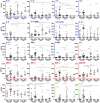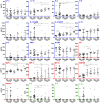Increased Age, but Not Parity Predisposes to Higher Bacteriuria Burdens Due to Streptococcus Urinary Tract Infection and Influences Bladder Cytokine Responses, Which Develop Independent of Tissue Bacterial Loads
- PMID: 27936166
- PMCID: PMC5147962
- DOI: 10.1371/journal.pone.0167732
Increased Age, but Not Parity Predisposes to Higher Bacteriuria Burdens Due to Streptococcus Urinary Tract Infection and Influences Bladder Cytokine Responses, Which Develop Independent of Tissue Bacterial Loads
Abstract
Streptococcus agalactiae causes urinary tract infection (UTI) in pregnant adults, non-pregnant adults, immune-compromised individuals and the elderly. The pathogenesis of S. agalactiae UTI in distinct patient populations is poorly understood. In this study, we used murine models of UTI incorporating young mice, aged and dam mice to show that uropathogenic S. agalactiae causes bacteriuria at significantly higher levels in aged mice compared to young mice and this occurs coincident with equivalent levels of bladder tissue colonisation at 24 h post-infection (p.i.). In addition, aged mice exhibited significantly higher bacteriuria burdens at 48 h compared to young mice, confirming a divergent pattern of bacterial colonization in the urinary tract of aged and young mice. Multiparous mice, in contrast, exhibited significantly lower urinary titres of S. agalactiae compared to age-matched nulliparous mice suggesting that parity enhances the ability of the host to control S. agalactiae bacteriuria. Additionally, we show that both age and parity alter the expression levels of several key regulatory and pro-inflammatory cytokines, which are known to be important the immune response to UTI, including Interleukin (IL)-1β, IL-12(p40), and Monocyte Chemoattractant Protein-1 (MCP-1). Finally, we demonstrate that other cytokines, including IL-17 are induced significantly in the S. agalactiae-infected bladder regardless of age and parity status. Collectively, these findings show that the host environment plays an important role in influencing the severity of S. agalactiae UTI; infection dynamics, particularly in the context of bacteriuria, depend on age and parity, which also affect the nature of innate immune responses to infection.
Conflict of interest statement
The authors have declared that no competing interests exist.
Figures




Similar articles
-
Pathogenesis of Streptococcus urinary tract infection depends on bacterial strain and β-hemolysin/cytolysin that mediates cytotoxicity, cytokine synthesis, inflammation and virulence.Sci Rep. 2016 Jul 7;6:29000. doi: 10.1038/srep29000. Sci Rep. 2016. PMID: 27383371 Free PMC article.
-
Immune activation and suppression by group B streptococcus in a murine model of urinary tract infection.Infect Immun. 2011 Sep;79(9):3588-95. doi: 10.1128/IAI.00122-11. Epub 2011 Jun 20. Infect Immun. 2011. PMID: 21690238 Free PMC article.
-
Host Cathelicidin Exacerbates Group B Streptococcus Urinary Tract Infection.mSphere. 2020 Apr 22;5(2):e00932-19. doi: 10.1128/mSphere.00932-19. mSphere. 2020. PMID: 32321824 Free PMC article.
-
The epidemiology of urinary tract infection and the concept of significant bacteriuria.Infection. 1990;18 Suppl 2:S40-3. doi: 10.1007/BF01643424. Infection. 1990. PMID: 2286458 Review.
-
Bacteruria and Urinary Tract Infections in the Elderly.Urol Clin North Am. 2015 Nov;42(4):561-8. doi: 10.1016/j.ucl.2015.07.002. Epub 2015 Aug 19. Urol Clin North Am. 2015. PMID: 26475952 Review.
Cited by
-
Roles of the vagina and the vaginal microbiota in urinary tract infection: evidence from clinical correlations and experimental models.GMS Infect Dis. 2020 Mar 26;8:Doc02. doi: 10.3205/id000046. eCollection 2020. GMS Infect Dis. 2020. PMID: 32373427 Free PMC article. Review.
-
Sex differences in IL-17 contribute to chronicity in male versus female urinary tract infection.JCI Insight. 2019 May 30;5(13):e122998. doi: 10.1172/jci.insight.122998. JCI Insight. 2019. PMID: 31145099 Free PMC article.
-
Determination of surface proteins profile, capsular genotyping, and antibiotic susceptibility patterns of Group B Streptococcus isolated from urinary tract infection of Iranian patients.BMC Res Notes. 2019 Jul 19;12(1):437. doi: 10.1186/s13104-019-4428-4. BMC Res Notes. 2019. PMID: 31324269 Free PMC article.
-
Urine Cytokine and Chemokine Levels Predict Urinary Tract Infection Severity Independent of Uropathogen, Urine Bacterial Burden, Host Genetics, and Host Age.Infect Immun. 2018 Aug 22;86(9):e00327-18. doi: 10.1128/IAI.00327-18. Print 2018 Sep. Infect Immun. 2018. PMID: 29891542 Free PMC article.
References
-
- Stamm WE, Norrby SR. Urinary tract infections: disease panorama and challenges. J Infect Dis. 2001;183 Suppl 1:S1–4. Epub 2001/02/15. - PubMed
-
- Foxman B. Epidemiology of urinary tract infections: incidence, morbidity, and economic costs. Am J Med. 2002;113 Suppl 1A:5S–13S. Epub 2002/07/13. - PubMed
-
- Guideline-Development-Group. Systematic review of health related quality of life for symptomatic UTI 2012. In: Infection: Prevention and Control of Healthcare-Associated Infections in Primary and Community Care: Partial Update of NICE Clinical Guideline 2 [Internet]. London: National Clinical Guideline CentreNational Institute for Health and Clinical Excellence: Guidance; [397–404]. Available from: http://www.ncbi.nlm.nih.gov/pubmed/23285500.
MeSH terms
Substances
LinkOut - more resources
Full Text Sources
Other Literature Sources
Medical
Research Materials
Miscellaneous

